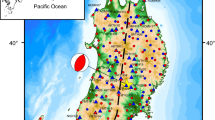Abstract
—We constructed a three-dimensional finite element model to simulate coseismic and postseismic displacement and stress fields associated with the 1993 Kushiro-oki earthquake, which was a very large intermediate-depth earthquake that occurred within the subducted Pacific plate at a depth of 107 km beneath the southeastern part of Hokkaido, Japan. Taking the configuration of the subducted Pacific plate into account, we constructed a realistic model with lateral heterogeneity of viscoelastic structure. We assigned a variable slip distribution to the fault plane, which was obtained from inversion analysis of near-field seismic waveforms. The result shows that elastic deformation associated with the faulting reflects the assigned inhomogeneous slip distribution on the fault plane near the fault region, while it does not reflect the distribution on the free surface of the model. The calculated postseismic deformation does not reflect the slip distribution, but shows symmetric spatial patterns concerning the dipping direction of the fault both near the fault region and on the model surface. For the next 20 years following the earthquake, the amount of the calculated deformation is a fraction of the coseismic deformation. The calculated coeseismic deformation is large just above and below the fault plane, reaching 1 m, while the postseismic deformation is dominant near the upper and lower material boundaries between the subducted plate and the surrounding asthenosphere. The spatial distribution of maximum shear stress near the fault plane corresponds to the assigned slip distribution, amounting to 32 MPa. The directions of principal stress-change axes represent reverse fault type in the SSE region of the fault, whereas normal fault type is dominant in the NNW region with the exception of some asymmetrical spatial patterns of the principal stress-change axes on the fault due to the inhomogeneous slip distribution. Time variations both in the amount and the directions of stresses are minor, suggesting that the coseismic state of the stress would remain unchanged for two decades after the event.
Similar content being viewed by others
Author information
Authors and Affiliations
Additional information
Received January 10, 1998, accepted April 15, 1998.
Rights and permissions
About this article
Cite this article
Yoshioka, S., Tokunaga, Y. Numerical Simulation of Displacement and Stress Fields Associated with the 1993 Kushiro-oki, Japan, Earthquake. Pure appl. geophys. 152, 443–464 (1998). https://doi.org/10.1007/s000240050162
Issue Date:
DOI: https://doi.org/10.1007/s000240050162




